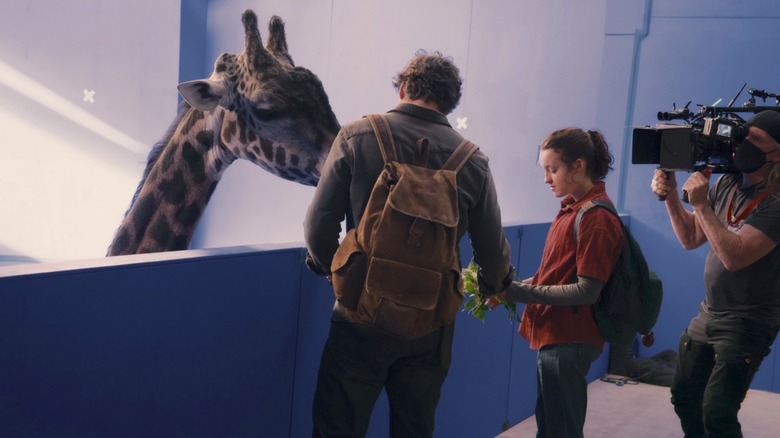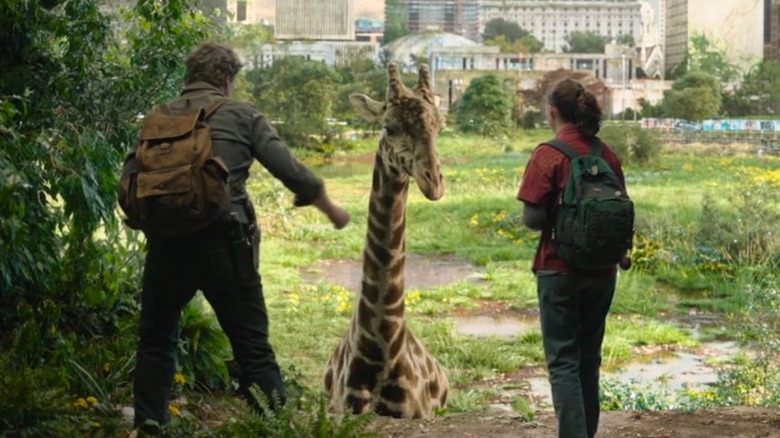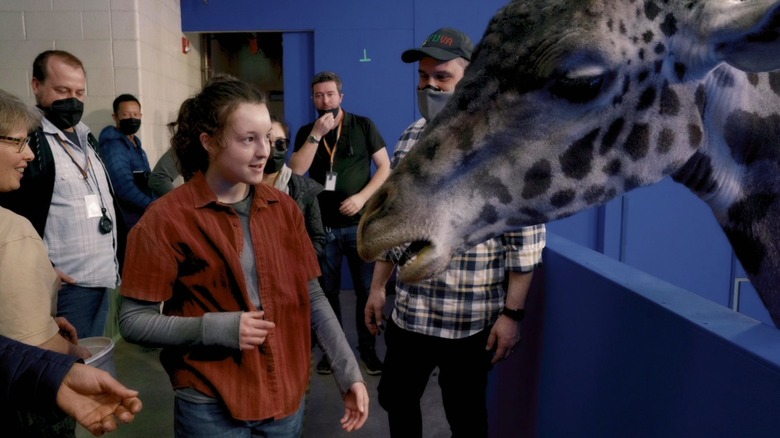Yes, They Used A Real Giraffe For The Last Of Us Season 1 Finale
This post contains spoilers for the season finale of "The Last of Us."
The giraffe scene in "The Last of Us" season finale is a perfect encapsulation of what the entire series is actually about: the balance between dark and light. Despite all the decaying, jagged wreckage and ruined remains of society, there's always life and beauty to be found in this world where you look for it. Sadness, loss, and grief are almost always accentuated with joy, catharsis, and love. Here, at the tail-end of Joel (Pedro Pascal) and Ellie's (Bella Ramsey) long journey, and in the traumatic aftermath of a harsh winter, Ellie is given one last moment to just be a kid. Oh, to experience child-like wonder feeding a giraffe in an overgrown and desolate Salt Lake City.
Our protagonists are just as aware as we are that the road ahead into this story's climax will not be easy, so they savor the view. In the game, the player is invited to sit and stare at the giraffes with Joel and Ellie until their heart's content, but there's only one way to progress. After all, it wouldn't be a moment of joy if it wasn't fleeting. Needless to say, as fans, we're thrilled this scene made it into the final episode of the HBO series. Though, they did look a lot wonkier than we expected, right? Well, if you assumed that they were fully CG creations, you'd be wrong.
In the "Making of The Last of Us" special that aired after the episode, we're treated to some behind-the-scenes footage of the scene in question — and yes, they have a real giraffe on set interacting with Pedro Pascal and Bella Ramsey.
'It's like a spiritual experience'
In the special, Ramsey expressed a great appreciation for being able to work with a real giraffe in a safe, set environment, stating: "Giraffes are pretty massive! It's like a spiritual experience, almost, being so close to such a magnificent animal."
Whenever possible, showrunners Craig Mazin and Neil Druckmann preferred to make use of physical sets and practical effects, such as the faithful recreation of the Jackson commune seen in episode 6, or the thrilling run-ins with the clickers in episode 2. Of course, there's always a level of unpredictability working with live animals, so making the giraffe scene happen required a little help from the VFX teams. The behind-the-scenes special showed the cast and crew interacting with the live giraffe's head peeking out from a set of blue screen walls.
"The Last of Us" was shot over the course of a year, mostly in Canada (something the creators want to stray away from in season 2, with all respect to Canada). During the "Making of The Last of Us," production designer John Paino shared how they worked around a giraffe enclosure to build the set:
"Fortunately the one thing Alberta does have is a zoo with giraffes, and we spent quite a while putting things in the enclosure so that we could shoot it, and getting the giraffes acclimated to panels with blue screen, so that we could just go in there and shoot the giraffe and have Ellie feed the giraffe."
The blend of CG and physical elements is common practice
Okay, so there was a real giraffe present on set. But, you might still be wondering, "why did it look like that?"
Sometimes, even when there are physical and real elements to a scene, it's not uncommon for productions to utilize CG to re-create or "enhance" them in post-production. We've actually seen this happen before in "The Last of Us" itself. Remember that horrifying child clicker (played by actor/contortionist Skye Cowton) from episode 5? While Cowton was physically there on set playing the clicker, the final product was actually a CGI recreation after a post-production decision to show more of Cowton's face hidden behind the prosthetic mask.
While the clicker scene had the benefit of dynamic, high-contrast lighting (which can help blend VFX elements naturally), the giraffe leaned towards the uncanny valley in comparison — however, there's still a physical element at play here. Thanks to early screeners that were made available to /Film, we can confirm that early versions of this scene contained a mixture of in-progress CG as well as real shots of the giraffe in question.
Most of the time, the reason why elements like these are altered in post-production is due to a specific vision and direction for the scene. It's possible the giraffe was not as expressive as expected or wasn't performing the actions the way Mazin, Druckmann, or episode director Ali Abbasi intended.
Either way, Pascal and Ramsey's performances and their physical reaction to the giraffe are authentic and real. Sure, the giraffe's VFX makeover isn't a complete home run, but the emotional weight of the scene is what matters most. It might not be everything we hoped for, but you can't deny the view.


